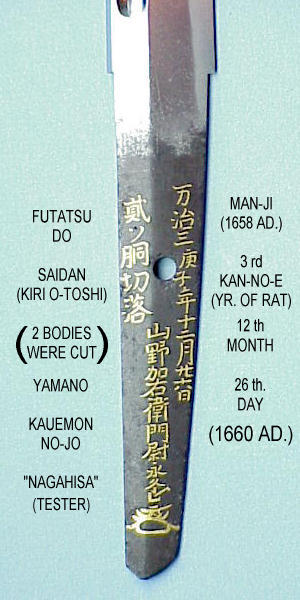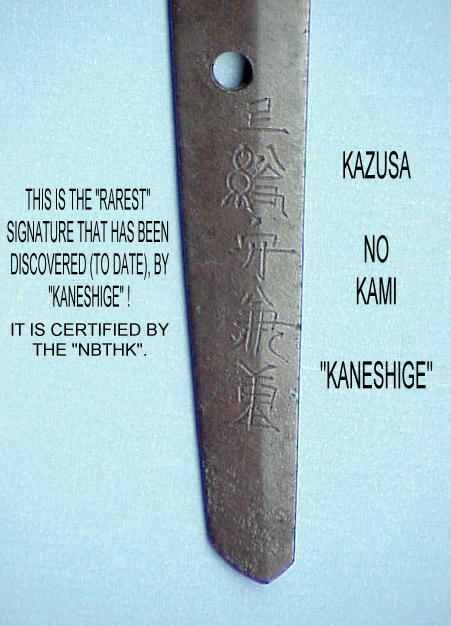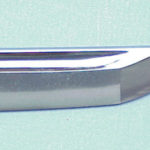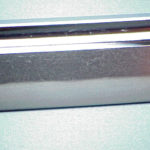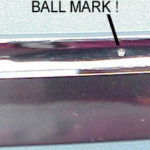Gallery Page (Display Only)
Description
This is an “Ultra rare Kaneshige”. It is signed with a style of signature that is the most extraordinary mei that anyone has ever seen. In addition to the rarity of finding a wakizashi with a cutting test, it also has battle marks from a matchlock. The “description” shown below was translated from an original paper, in kanji. Unfortunately the former cannot locate it.
Description:
Kazusa-no-Kami Kaneshige wakizashi
Signed: Kazusa-no-Kami Kaneshige with gold inlay of Tokugawa Shogun sword tester Yamano Nagahisa
Cutting test:
Kinzogan mei (gold inlay).
Futatsu-do-saidan (Kiri O-toshi)
Man-Ji San Kan-no-e Ne Nen Ju-Ni Gatsu Ni-ju Roku Hi
Yamano Kauemon-no-Jo Nagahisa (Kao)
On the morning of the 26th Day, 12th Month of the year of the Rat, 1660 AD, 1 cut – two bodies.
NBTHK Tokubetsu Hozon certificate
Nagasa: 51.8 cm ~ 20 7/16″
Sori: 1.2 cm ~ 1/2″
Motohaba: 3.2 cm ~ 1 1/4″
Kirikomi: Kaku-umegane repair to the bo-hi. Due matchlock ball strike(s)
“Formerly in the possession of the Omiya family of Nara (previously indicated on lost certificate, prior to the current Tokuho cert). Kotestsu and Kaneshige style are the same. Kaneshige made Gassaku (collaboration work) with the 3rd generation Yasutsugu and Hojoji Masatsune. Kotestu style is un-usually mistakenable in the Chu-width Gunome, riding a gently Midare line. Nie Sunagashi brushes a distinct Habuchi and falling Ashi makes the famous mark. The Nakago is perfect. The color is very dark and excellent (pictures are balanced to the blade). Yasuri stands strongly. The mei is extraordinarily – truly unusual; and perhaps the finest on record Kazusa no Kami Kaneshige.” Notes are from the files of the late David EJ Pepin.



The Omiya name extends back to Kyoto into the early 17 th century where the Omiya Palace was constructed, by the Shogun Tokugawa for the retired Emperor Gomizuno and Empress Dowager Tofukumon-in and the present palace was built for the Empress Dowager Eishou, (the spouse of Emperor Komei) and was completed in 1867. Emperor Komei’s wife was from the “Omiya” Family. The palace is currently used for Imperial stopovers during tours of the provinces and as a place where state guests may stopover.
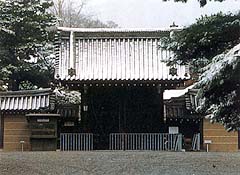
(Photo:Imperial Household Agency)
The name of the aristocratic class that dominated the Japanese imperial court in Kyoto was the kuge (??). The Omiya were members of the Fujiwara clan and the Urinke????) (military) subclass.The kuge led the court until the Shogunate came into power in the 12 th century, when the Japanese imperial court was then overshadowed by the daimyo. Even so, the kuge was still a presence around the Emperor until the Meiji Restoration.
Kuge first described the Emperor and his court. Eventually, kuge described bureaucrats at the court. In the Kamakura period, kuge became the opposite of buke, a warrior’s house, meaning a samurai loyal to the Shogunate. At that time, kuge was used to designate people who worked in the Court, including both aristocratic noblemen and commoners. There were 2 classes formed from kuge: d?j? (??) (noblemen) were allowed to sit with the Emperor; and jige (??), who were not allowed to sit with the Emperor.
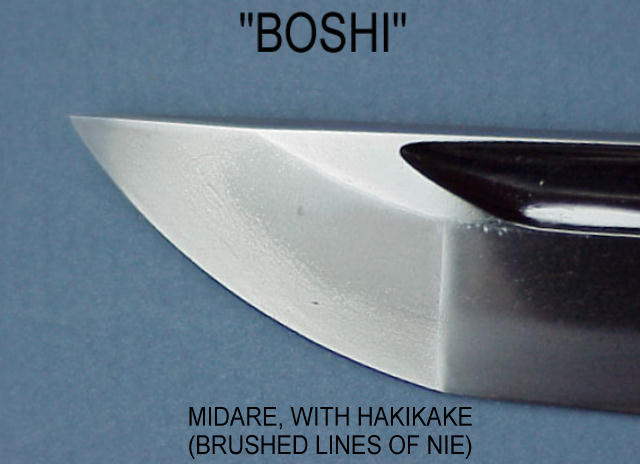
Kinzogan mei (gold inlay).
Futatsu-do-saidan (Kiri O-toshi)
Man-Ji San Kan-no-e Ne Nen Ju-Ni Gatsu Ni-ju Roku Hi
Yamano Kauemon-no-Jo Nagahisa (Kao)
On the morning of the 26th Day, 12th Month of the year of the Rat, 1660 AD, 1 cut – two bodies.
Gallery
This Sword is not available for purchase.
If you wish to purchase a Japanese Sword please view our Nihonto for sale page or contact us directly via email or contact us at 1(608) 315-0083 any time, please include specifics of what you seek, i.e.: Katana, maker, era, price range etc.
Pictures and content may not be copied without the express permission of samuraisword.com ©



